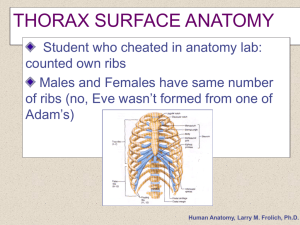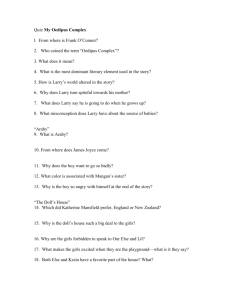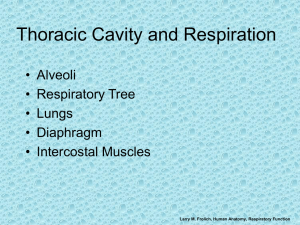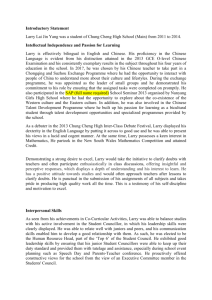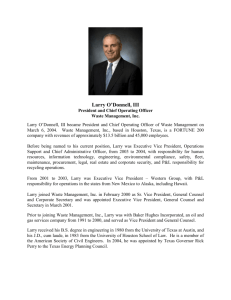Cells2ForAandP
advertisement
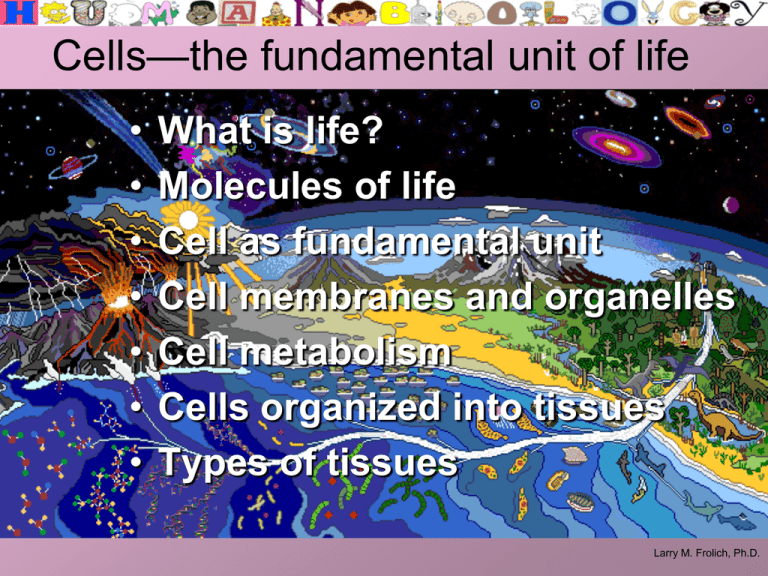
Cells—the fundamental unit of life • • • • • • • What is life? Molecules of life Cell as fundamental unit Cell membranes and organelles Cell metabolism Cells organized into tissues Types of tissues Larry M. Frolich, Ph.D. What is Life? • Life needs energy • Life reproduces • Life grows and develops • Life maintains a stable condition— homeostasis • Life responds to stimulus • Life is organized because it has evolved Larry M. Frolich, Ph.D. Cells are fundamental unit of life • Cells are the basic and fundamental unit of life • The first life was cellular life • The Molecules of Life are what cells and all their internal parts are made up of Larry M. Frolich, Ph.D. Cells—the fundamental unit of life • What is life? •Molecules of life • • • • • Cell as fundamental unit Cell membranes and organelles Cell metabolism Cells organized into tissues Types of tissues Larry M. Frolich, Ph.D. The Carbon-chain Molecules of Life MOLECULE MADE OF FUNCTION Carbohydrates Simple Sugars Energy Proteins Amino Acids Fats Fatty Acids DNA/RNA Nucleotides (bases) Catalyze reactions Cell membranes Information Larry M. Frolich, Ph.D. Carbohydrates • Components are simple sugars • Used for energy storage in complex form • Broken down to simple sugars to fuel cellular metabolism in mitochondria • So, why are simple sugars bad for us? And why do we love them so much? (p. 29 in text) Larry M. Frolich, Ph.D. Proteins • Components are amino acids • Very complicated • Amino acid chain folds up to give complex form • Complex form allows for catalyzing very specific chemical reactino • GenBlue Larry M. Frolich, Ph.D. Fats/Lipids • Fundamental to life and origins—separate cell interior from environment as cell membrane • Mammals and other vertebrates—long-term energy storage • Role in diet=big controversy! Larry M. Frolich, Ph.D. DNA/RNA (Nucleic Acids) • DNA and RNA store and use information • Components are nucleotides or “bases” (A,C,T/U,G) • One DNA molecule can be very long and complex—millions of bases long • DNA duplicates to pass on information • Transcription to mRNA to be translated into protein’s amino acid chain Larry M. Frolich, Ph.D. • What do proteins do? Cells—the fundamental unit of life • What is life? • Molecules of life • Cell as fundamental unit • • • • Cell membranes and organelles Cell metabolism Cells organized into tissues Types of tissues Larry M. Frolich, Ph.D. Cells are fundamental unit of life • Cells are the basic and fundamental unit of life • The first life was cellular life • The Molecules of Life are what cells and all their internal parts are made up of Larry M. Frolich, Ph.D. Two types of cells • Prokaryotic cells – Relatively Simple – Relatively Small – No organelles with Molecules of Life distributed throughout cytoplasm – Bacteria are all prokaryotic cells • Eukaryotic cells – More complex – Much bigger (100 x size of prokaryotic cells) – Internally organized with membrane-bound organelles – Multi-cellular organisms, like plants and animals, are all made up of eukaryotic cells Larry M. Frolich, Ph.D. Eukaryotic cell Larry M. Frolich, Ph.D. Endosymbiotic origin of mitochondria and chloroplasts • Eukaryotic cells evolved from fusion or integration of prokaryotic cells • Best evidence is in bacterial or prokaryotic appearance of mitochondria and chloroplasts • These organelles are like little bacterial cells within our cells, now fully functionally integrated • They perform fundamental cell functions. Mitochondria process sugars to produce energy; chloroplasts make sugars by photosynthesis • But they maintain their own DNA and genetic control Larry M. Frolich, Ph.D. Prokaryotic cells have: • Cell membrane • DNA molecule loose in cytoplasm • Small Ribosomes where proteins are assembled from DNA information • Microtubule structures like flagella and cilia • Mitochondria and chloroplasts share most of these features, including their own independent DNA Larry M. Frolich, Ph.D. Eukaryotic cells (like our human cells) have: WHAT EUKARYOTIC CELLS HAVE: • Cell membrane • Nucleus • Mitochondria (and sometimes chloroplasts for photosynthesis) • Larger ribosomes for protein assembly from DNA information • Internal membranes that organize cellular spaces and distribution of Molecules of Life within cell (“cytoskeleton”) Larry M. Frolich, Ph.D. WHAT CAN EUKARYOTIC CELLS DO? WHAT STRUCTURES ARE INVOLVED? Separate inside of cell from external environment and control what substances pass across membrane Cell Membrane Produce proteins/enzymes that catalyze chemical reactions or control movement across membrane Nucleus (DNA), Ribosomes on rough endoplasmic reticulum Break down sugars to form energy which is stored in phosphate bonds of ATP Mitochondria Organize distribution of Molecules of Life (macromolecules) and ions throughout cell Internal membrane system and “cytoskeleton” (ER, lysosomes, vessicles, microtubules) Move Flagella, cilia, pseudopods Larry M. Frolich, Ph.D. Cells—the fundamental unit of life • What is life? • Molecules of life • Cell as fundamental unit • Cell membranes and organelles • Cell metabolism • Cells organized into tissues • Types of tissues Larry M. Frolich, Ph.D. A cell membrane or plasma membrane separates cell from outside world—creates ability to regulate internal environment (homeostasis) Larry M. Frolich, Ph.D. cell membrane Larry M. Frolich, Ph.D. cell membrane What are some characteristics of the plasma membrane? • It is a phospholipid bilayer • It is embedded with proteins that move in space • It contains cholesterol for support • It contains carbohydrates on proteins and lipids • Selectively permeable Larry M. Frolich, Ph.D. cell membrane What does selectively permeable mean? • The membrane allows some things in while keeping other substances out Larry M. Frolich, Ph.D. cell membrane How do things move across the plasma membrane? 1. 2. 3. 4. 5. Diffusion Osmosis Facilitated transport Active transport Endocytosis and exocytosis Larry M. Frolich, Ph.D. cell membrane What are diffusion and osmosis? • 1. Diffusion is the random movement of molecules from a higher concentration to a lower concentration • 2. Osmosis is the diffusion of water molecules Larry M. Frolich, Ph.D. cell membrane How does tonicity change a cell? • Hypertonic solutions have more solute than the inside of the cell and lead to lysis (bursting) • Hypotonic solutions have less solute than the inside of the cell and lead to crenation (shriveling) • Isotonic solutions have equal amounts of solute inside and outside the cell and thus does not affect the cell Larry M. Frolich, Ph.D. cell membrane What are facilitated diffusion and active transport? • 3. Facilitated transport is the transport of molecules across the plasma membrane from higher concentration to lower concentration via a protein carrier • 4. Active transport is the movement of molecules from a lower to higher concentration using ATP as energy; requires a protein carrier Larry M. Frolich, Ph.D. What are endocytosis and exocytosis? cell membrane • 5. Endocytosis transports molecules or cells into the cell via invagination of the plasma membrane to form a vesicle • 6. Exocytosis transports molecules outside the cell via fusion of a vesicle with the plasma membrane Larry M. Frolich, Ph.D. Protein synthesis • Remember that proteins control cell metabolism—how and where are they made, or synthesized in the cell? Larry M. Frolich, Ph.D. Protein synthesis What structures are involved in protein synthesis? • Nucleus • Ribosomes • Endomembrane system Larry M. Frolich, Ph.D. Protein synthesis What is the structure and function of the nucleus? • Bound by a porous nuclear envelope • Houses DNA and associated proteins called chromatin • Contains nucleoplasm • Nucleolus region(s) that contain ribosomal RNA (rRNA) Larry M. Frolich, Ph.D. Protein synthesis What is the structure and function of ribosomes? • Organelles made of RNA and protein • Found bound to the endoplasmic reticulum and free floating in the cell • Site of protein synthesis Larry M. Frolich, Ph.D. Protein synthesis What is the endomembrane system? • A series of membranes in which molecules are transported in the cell • It consists of the nuclear envelope, endoplasmic reticulum, Golgi apparatus, lysosomes and vesicles Larry M. Frolich, Ph.D. How does the endomembrane system function and appear? Protein synthesis Larry M. Frolich, Ph.D. Protein synthesis Summary of the parts of the endomembrane system? • Rough endoplasmic reticulum – studded with ribosomes used to make proteins • Smooth endoplasmic reticulum – lacks ribosomes but aids in making carbohydrates and lipids • Golgi apparatus – flattened stacks that process, package and deliver proteins and lipids from the ER • Lysosomes – membranous vesicles made by the Golgi that contain digestive enzymes • Vesicles – small membranous sacs used for transport Larry M. Frolich, Ph.D. What are cilia and flagella? • Both are made of microtubules • Both are used in movement • Cilia are about 20x shorter than flagella Larry M. Frolich, Ph.D. What do mitochondria do and what do they look like? • A highly folded organelle in eukaryotic cells • Produces energy in the form of ATP • They are thought to be derived from an engulfed prokaryotic cell Larry M. Frolich, Ph.D. Cells—the fundamental unit of life • • • • What is life? Molecules of life Cell as fundamental unit Cell membranes and organelles • Cell metabolism • Cells organized into tissues • Types of tissues Larry M. Frolich, Ph.D. • • • • What is cellular respiration? Occurs in the mitochondria Production of ATP in a cell Usually glucose is main “energy” molecule enters cellular respiration Includes: – – – Glycolysis Citric acid cycle 3. Electron transport chain Larry M. Frolich, Ph.D. What other molecules besides glucose can be used in cellular respiration? • Other carbohydrates • Proteins • Lipids Larry M. Frolich, Ph.D. How can a cell make ATP without oxygen? • Fermentation – Occurs in the cytoplasm – Does not require oxygen – Involves glycolysis – Makes 2 ATP and lactate in human cells – Is important in humans for a burst of energy for a short time Larry M. Frolich, Ph.D. All of cell metabolism • Cell metabolism is much more than simply making ATP, or cellular respiration, which is just how the cell has an energy supply. • What does the cell do with that energy? • Get ready for what you are about to see… • The cell runs all the reactions that make it alive— see the first part of this presentation: grow, reproduce, develop, move, maintain internal homeostasis, respond to stimuli. • This involves a LOT of chemical reactions. • Here it is: most of the reactions involved in keeping the simplest of cells—an E. coli bacteria— alive! Larry M. Frolich, Ph.D. Ecocyc—database of complete E. coli metabolism Larry M. Frolich, Ph.D. What’s it all mean? • • • Every little box represents a stage in a particular chemical reaction. The sum of those reactions is the total cell metabolism—what makes the cell alive! You’ll actually visit the ecocyc database under the web links for this section as the last thing you do Remember three things: 1. every one of these reactions is catalyzed by a protein 2. The amino acid sequence for those proteins are coded for in the DNA 3. The world’s biggest super-computers are trying to figure out how, based on their unique amino acid sequence, all the different cellular proteins take on the particular shape they have, and control the particular reaction they catalyze. (You’ll also visit the Blue Gene IBM super-computer website in the web links for this section.) Larry M. Frolich, Ph.D. Cells—the fundamental unit of life (review) • • • • • • • What is life? Molecules of life Cell as fundamental unit Cell membranes and organelles Cell metabolism Cells organized into tissues Types of tissues Larry M. Frolich, Ph.D. What is Life? • Life needs energy • Life reproduces • Life grows and develops • Life maintains a stable condition— homeostasis • Life responds to stimulus • Life is organized because it has evolved Larry M. Frolich, Ph.D. The Carbon-chain Molecules of Life MOLECULE MADE OF FUNCTION Carbohydrates Simple Sugars Energy Proteins Amino Acids Fats Fatty Acids DNA/RNA Nucleotides (bases) Catalyze reactions Cell membranes Information Larry M. Frolich, Ph.D. Cells are fundamental unit of life • Cells are the basic and fundamental unit of life • The first life was cellular life • The Molecules of Life are what cells and all their internal parts are made up of Larry M. Frolich, Ph.D. WHAT CAN EUKARYOTIC CELLS DO? WHAT STRUCTURES ARE INVOLVED? Separate inside of cell from external environment and control what substances pass across membrane Cell Membrane Produce proteins/enzymes that catalyze chemical reactions or control movement across membrane Nucleus (DNA), Ribosomes on rough endoplasmic reticulum Break down sugars to form energy which is stored in phosphate bonds of ATP Mitochondria Organize distribution of Molecules of Life (macromolecules) and ions throughout cell Internal membrane system and “cytoskeleton” (ER, lysosomes, vessicles, microtubules) Move Flagella, cilia, pseudopods Larry M. Frolich, Ph.D. A cell membrane or plasma membrane separates cell from outside world—creates ability to regulate internal environment (homeostasis) Larry M. Frolich, Ph.D. Protein synthesis • Remember that proteins control cell metabolism—how and where are they made, or synthesized in the cell? Larry M. Frolich, Ph.D. Ecocyc—database of complete E. coli metabolism Larry M. Frolich, Ph.D. What is a tissue? • • • Multi-cellular organisms are composed of millions and millions of cells whose metabolism is organized to work together. A tissue is a collection of cells of the same type that perform a common function There are 4 major tissue types in the body: 1. 2. 3. 4. Connective Muscular Nervous Epithelial Larry M. Frolich, Ph.D. This initial review of life and cells is crucial! • Please read your book chapters, review the web links and get this part of the course. • We’ll come back to cells and how they work again and again. • I am aware this is a LOT of information! • But master this, and the rest of the course will seem easy. Larry M. Frolich, Ph.D.
